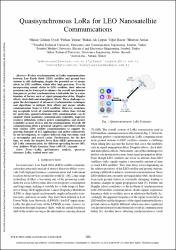| dc.contributor.author | Uysal, Hasan Gökhan | |
| dc.contributor.author | Yılmaz, Ferkan | |
| dc.contributor.author | Çırpan, Hakan Ali | |
| dc.contributor.author | Kucur, Oğuz | |
| dc.contributor.author | Arslan, Hüseyin | |
| dc.date.accessioned | 2023-12-19T05:59:47Z | |
| dc.date.available | 2023-12-19T05:59:47Z | |
| dc.date.issued | 2023 | en_US |
| dc.identifier.citation | Uysal, H. G., Yılmaz, F., Çırpan, H. A., Kucur, O. ve Arslan, H. (2023). Quasisynchronous LoRa for LEO nanosatellite communications. IEEE International Black Sea Conference on Communications and Networking, BlackSeaCom 2023 içinde (181-185. ss.). Istanbul, 4-7 July 2023. https://dx.doi.org/10.1109/BlackSeaCom58138.2023.10299744 | en_US |
| dc.identifier.isbn | 9798350337822 | |
| dc.identifier.uri | https://dx.doi.org/10.1109/BlackSeaCom58138.2023.10299744 | |
| dc.identifier.uri | https://hdl.handle.net/20.500.12511/12023 | |
| dc.description.abstract | Perfect synchronization in LoRa communications between Low Earth Orbit (LEO) satellites and ground base stations is still challenging, despite the potential use of atomic clocks in LEO satellites, which offer high precision. Even by incorporating atomic clocks in LEO satellites, their inherent precision can be leveraged to enhance the overall synchronization process, perfect synchronization is infeasible due to a combination of factors such as signal propagation delay, Doppler effects, clock drift and atmospheric effects. These challenges require the development of advanced synchronization techniques and algorithms to mitigate their effects and ensure reliable communication from / to LEO satellites. However, maintaining acceptable levels of synchronization rather than striving for perfection, quasisynchronous (QS) communication can be adopted which maintains communication reliability, improves resource utilization, reduces power consumption, and ensures scalability as more devices join the communication. Overall, QS communication offers a practical, adaptive, and robust solution that enables LEO satellite communications to support the growing demands of IoT applications and global connectivity. In our investigation, we explore different chip waveforms such as rectangular and raised cosine. Furthermore, for the first time, we study the Symbol Error Rate (SER) performance of QS LoRa communication, for different spreading factors (SF), over Additive White Gaussian Noise (AWGN) channels. | en_US |
| dc.description.sponsorship | IEEE Communications Society | en_US |
| dc.language.iso | eng | en_US |
| dc.publisher | Institute of Electrical and Electronics Engineers Inc. | en_US |
| dc.rights | info:eu-repo/semantics/openAccess | en_US |
| dc.subject | LoRa | en_US |
| dc.subject | Performance Analysis | en_US |
| dc.subject | Quasisynchronous LoRa | en_US |
| dc.subject | Symbol Error Rate | en_US |
| dc.title | Quasisynchronous LoRa for LEO nanosatellite communications | en_US |
| dc.type | article | en_US |
| dc.relation.ispartof | IEEE International Black Sea Conference on Communications and Networking, BlackSeaCom 2023 | en_US |
| dc.department | İstanbul Medipol Üniversitesi, Mühendislik ve Doğa Bilimleri Fakültesi, Elektrik ve Elektronik Mühendisliği Bölümü | en_US |
| dc.authorid | 0000-0001-9474-7372 | en_US |
| dc.identifier.startpage | 181 | en_US |
| dc.identifier.endpage | 185 | en_US |
| dc.relation.publicationcategory | Konferans Öğesi - Uluslararası - Kurum Öğretim Elemanı | en_US |
| dc.identifier.doi | 10.1109/BlackSeaCom58138.2023.10299744 | en_US |
| dc.institutionauthor | Arslan, Hüseyin | |
| dc.identifier.scopus | 2-s2.0-85178994935 | en_US |


















